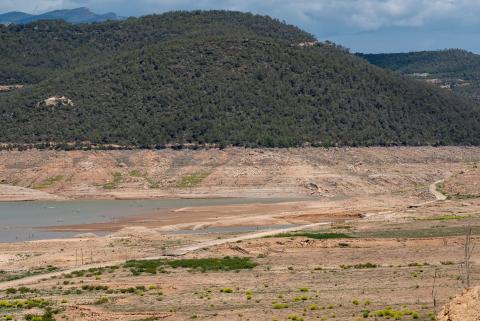What is an attribution study?
This is research that calculates whether a particular weather phenomenon is more likely or more intense due to climate change.
The germ of such research is thought to date back to January 2003, when climate scientist Myles Allen of Oxford University (UK) watched helplessly as his kitchen began to flood. Ben Clarke and Friederike Otto explain in the World Weather Attribution (WWA) handbook How to Report Extreme Weather and Climate Change (2022).
"The waters of the River Thames are about 30 centimetres from my kitchen door and rising slowly. On the radio, a representative of the Met Office has just explained that, although this is the kind of phenomenon that global warming could make more frequent, it is impossible to attribute this particular event (flooding in southern England) to past greenhouse gas emissions," Allen wrote in an article published in the journal Nature.
Twenty years later, scientific and technical advances and a better understanding of climate mean that such attributions are possible and frequent, albeit with certain limitations depending on the type of event in question.
What does an attribution study tell us?
It can tell us whether global warming has made or will make an event more likely than it would have been without the increase in greenhouse gases from burning fossil fuels. As the Climate department of the US National Oceanic and Atmospheric Administration (NOAA) points out, such studies can also tell us whether the average number of years between similar events is higher or lower than before, and even what the risk of a particular extreme weather event is, by calculating whether global warming has increased that risk.
For example, between 2015 and 2017, South Africa's Western Cape province (in Cape Town) experienced below-normal rainfall and alarmingly depleted water supplies across the region. The WWA attribution study concluded that although such an event remains rare - occurring approximately every 100 years - the likelihood had tripled due to climate change.
And what don't these studies tell us?
They can't tell us whether global warming "caused" a particular event. "When most people ask if something caused something else ('Did global warming cause the Louisiana floods?') they want a yes or no answer. But in the case of global warming and extreme events, it's not a yes or no answer," NOAA Climate reminds us.
The question is whether global warming has added to the range of factors that already cause extreme events to occur. Global warming may be one of the causes of a phenomenon, but it is not the only one, at least for the time being.
How is an attribution analysis done?
The first step is to define the extreme phenomenon to be analysed, since, for example, a heat wave in the UK does not have the same parameters as a heat wave in Spain.
Once this has been done, attribution studies currently group three interrelated methods. First, simulating and comparing modern and pre-industrial climate with climate models. Many different atmospheric models are used to achieve greater accuracy.
The second part uses a method that incorporates observations on data from the present and the past to see how the probabilities between similar phenomena have changed.
The final part uses climate models, but instead of simulating the planet with and without human influence, it simulates the climate from a historical date to the present day, with increasing greenhouse gas emissions. This allows extreme trends to be detected, as well as calculating overall probability changes.
What is considered the first attribution study?
The first on extreme events was published in the journal Nature in December 2004 and analysed the link between the heat wave that hit Europe in the summer of 2003 and climate change. An estimated 70,000 people died.
The research concluded that the effect of human-induced climate change had made events like that hot European summer at least twice as likely.
How long does it take to conduct such an investigation?
The UK Met Office points out that such studies can be time-consuming because, as we have seen, they are based on processing and analysing large amounts of data. They involve collecting observations, using computer models to simulate the Earth's climate and analysing the results.
"However, thanks to new scientific advances, they are much faster. Today, we can sometimes complete attribution studies weeks after an event, rather than years," the Met Office notes.
"Today, we can sometimes complete attribution studies weeks after an event, rather than years"
Met Office
This is the case of the World Weather Attribution (WWA) rapid attribution studies, the results of which are published days or weeks after the event. According to the organisation, the aim is to inform the debate on climate change, mitigation and adaptation when the effects of the extreme event are still fresh in the minds of citizens and policy makers, and decisions are being made about reconstruction, should there be damage.
One example is the rapid attribution study published by WWA just a couple of weeks after the unusually high heat episode at the end of April 2023 that we experienced in the Iberian Peninsula, Morocco and Algeria. Its conclusion: climate change made this episode 100 times more likely to occur, with temperatures up to 3.5°C higher than they would have been without the climate crisis.
Do they follow a peer review process?
It depends on the study. Due to the short time frame, WWA rapid attribution studies do not follow a peer review process (i.e. they are not reviewed by independent experts before publication). However, the WWA reports that they follow established methods that have been peer-reviewed and assessed as scientifically reliable. "The rapid attribution methodology developed by WWA has passed all filters associated with peer review, has been applied on many other occasions, is well-tested and scientifically sound," meteorologist Ernesto Rodríguez Camino told SMC Spain.
Other attribution studies do follow a standard peer-review process and are published in scientific journals.
What are their limitations?
"At present, attribution results are strongest for heat waves, gradually changing conditions that cover a large area, such as sea level rise, global mean temperature or Arctic sea ice extent. Trying to quantify the extent to which climate change increased precipitation extremes remains a challenge and is an active area of research," says Radley Horton, a climate scientist at the Lamont-Doherty Earth Observatory at Columbia's School of Climate in the United States.
Climate models are less reliable for extreme precipitation because they work with grids that cover large spatial areas, whereas torrential precipitation tends to occur in relatively narrow geographic bands. Moreover, at present, climate models do not have a fine enough spatial resolution to deal with the many parameters of extreme precipitation, largely because they lack sufficient computational power.
However, Horton is optimistic for the future: "Every five to ten years we have more data per year, so we are better able to estimate what the initial risk is, because we are talking about very rare events. "We will also have new data devices, such as satellites, that can help us look at cloud temperatures and estimate precipitation in places where there may not be many weather stations. But I think the most important thing will be that, as our computing power increases, those grids will get finer and smaller. We will have higher resolution models," he adds.
And how can extreme phenomena be reported when there is no attribution study?
As WWA reminds us, attribution studies cannot be carried out for all extreme events, but thanks to other attribution studies and climate projections by bodies such as the IPCC, experts have a good understanding of the changes in different phenomena as the planet warms.
For example, we know that heat waves are now stronger and more likely due to human-induced climate change. However, droughts, snowstorms, tropical storms and forest fires are more complicated phenomena whose relationship to global warming is more complex.
Moreover, in the manual How to report on extreme weather and climate change, the authors stress that journalists should emphasise that natural disasters are more than just extreme weather: "When reporting on extreme events it is crucial to emphasise that, apart from climate change, natural hazards such as floods, droughts and heat waves become disasters as a result of society's vulnerability".
"Who and what gets in the way of the event determines whether it becomes a natural disaster or not. It is often the socio-economic status that determines the nature of prominent and disproportionate impacts. Moreover, many natural hazards are not just caused by nature: they are more likely and more intense due to climate change," says the handbook, which distinguishes how to report according to each type of phenomenon: heat waves, floods, tropical cyclones (hurricanes, typhoons and cyclones), heavy snowfall, droughts and fires.



